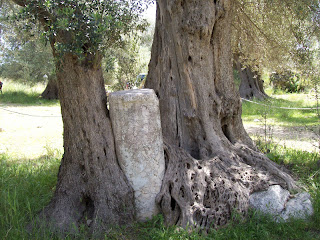Or Gortyn, or
Gortis, or any number of variants.
Whatever it is, we ditched the GPS today. It is proving almost worthless except for
finding the bigger towns. I suspect this
has to do with spelling, but the GPS doesn’t recognize any of the versions of
town names that are on any of our maps.
Fortunately, all the villages are very well marked with road signs, so
if you have a decent map it is easy to navigate by tracking your position from
village to village – sort of like subway stops.
As you might
have guessed we went to ancient Gortys this morning.
We started at the main tourist site, with a display of the many statues that were found at the site. Apparently, there are more to see in the Heraklion museum.
The main site where all the tour buses stop
has an Odeon (small theatre) that was once a Greek construction and, as usual,
was later added to by the Romans. You
can clearly see the older ashlar blocks with the newer Roman brick and mortar
right beside.
 |
| This is the Odeon, although for some reason, it is called an Odeum here in Greece, which kind of takes the pun out of Ian's jokes. It's spelled with an "N" in Greek. . . |
|
 |
| Ashlar, (Hellenic and on the left) added to by brick (Roman, and on the right. |
|
Inside the passage that
leads around the back of the Odeon there is inscribed on the wall the Gortyn
Law Code that was in force in the Greek times (5th C BC). It is one of the earliest written law codes
surviving.
 |
| The actual Code of Gortys. It is influenced by moth tribal and Minoan Law, but is the first attempt that we know of to write actual statutes. You read one line left to right, and the next line right to left. Ian couldn't quite figure it out. |
|
 |
| The code is on the left wall. |
|
There is also
the partial ruin of the church called Agios Tito, which is a Fourth Century Church built over the remains of St. Tito, who was a disciple of the Apostle Paul and the First Bishop of Crete.
 |
| This is an amazingly photogenic church, and absolutely full of doves and pigeons! |
However, there is much more to the site than
where the tour buses stop. It was a
large city and Roman provincial capital of Crete
in its day. We had a great time walking
through olive groves and flocks of sheep to view the Pritorium, baths and Temple of Apollo.
 |
| The Praetorum, from which all of Crete and the Province of Libya as well were ruled under Roman times. |
|
 |
| a pile of pottery fragments |
|
 |
| A tomb with benches on top. We saw some like this in Hierapolis |
|
 |
| Some fellow tourists |
|
Immediately
across the road from the main site there is a “Monumental” Olive Tree. Apparently there are a number of these
ancient and venerable trees classed as monuments. This one had grown up around the remains of a
Roman era column. Some of the trees are
claimed to be over one thousand years old.
We also went
to view a tomb called Agia Deka. This is
the tomb of the 10 Martyrs. It honours
10 Christians who were martyred under the reign of Decius in 280 AD. We also went to see the 12th C
church called Agia Deka (Deka for 10 after the 10 Martyrs close by), but it was
closed.
 |
| The tomb of the ten martyrs |
|
 |
| The church at Aghia Deko |
|
After that we
had excellent ice cream and then returned to our cabin. There are a number of hikes around the resort,
including one to the Monastery of Agia Nikolaos that was only supposed to be
about 1.5 hours. It goes by a crystal
clear “lake’ that reminds me of a something that might be made in a Municipal
park. Somehow, we took the wrong turn
down the goat path (literally) and ended up circumnavigating the lake. When we ended up back where we started we
tried again and went the right way this time, eventually getting to the Monastery,
meeting a monk who was shooing goats out of his garden and getting in to see
the small 14th C church where the priest made sure I took my hat
off, and Margaret had to take hers off too.
The icons that lined the walls had such expressive faces.
Very hot, as it
was 28 degrees and our path climbed 490 metres, both times we did it, we
returned to our cabin and then had a swim in the blessedly cool pool.




















No comments:
Post a Comment